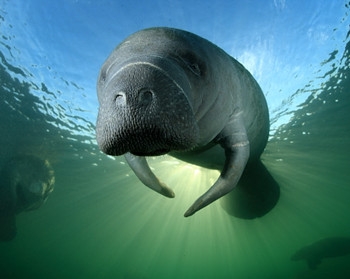
This creates steam in oasis and a profusion of life. Today, these warm springs are a refuge for one of Florida's most tropical inhabitants. The West Indian Manatee wasn't present during the last ice age, but returned here as the waters warmed up.
這使得綠洲之中產生了小溪也同時孕育了大量的生命。如今,這些溫泉成為了佛羅里達一種最具熱帶特色的生物的避難所。西印度海牛在冰河時代末期并不存在,但是當這里的溫度升到后來到了這里。
Even now, it is only found around this subtropical tip of the continent. But these springs aren't just a haven for modern day wildlife. They've also yielded many secrets of the distant past.
即使現在,我們也僅僅能在這塊大陸的亞熱帶地區發現他們的蹤影,但是這些溫泉并不只是現代野生動物們的天堂,他們還蘊含著遙遠過去的秘密。
When these pools were first explored, they would have looked like this, strewn with astonishing fossil remains from ice age beasts.
當這些溫泉最初被探索的時候,他們應該是這幅模樣,到處都是存在于冰河時代的動物們驚人的化石和骨骼。
Florida has one of the richest fossil records of the ice age anywhere on earth. So what kind of creatures did such bones and skulls belong to? And how did these springs become their graveyards?
佛羅里達是在世界上擁有冰河時代化石記錄最多的地區之一。那么這些骨骼和頭骨們有屬于那些動物呢?而這些動物又怎么葬身于此?
Many of the fossils are from animals that you can still see today. Indeed, we've recognized the vast majority of Florida's ice age wildlife. Nevertheless, the most spectacular ice age beast did become extinct. And remarkably, some of them share a common ancestor with modern manatees.
很多的化石都屬于那些今天我們還能看到的動物。確實,我們能夠識別出佛羅里達大部分的冰河時代動物化石。然而,那些最為壯麗的冰河時代動物已經滅絕。讓人吃驚的是,他們之中的一些動物和現代的海牛屬于同一祖先的后裔。
英文文本來自普特英語,譯文屬可可原創,僅供學習交流使用,未經許可請勿轉載.











